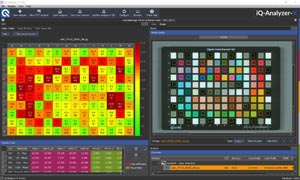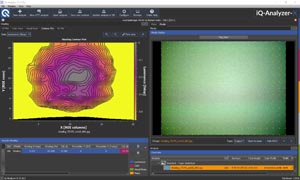Image Quality Factors testing
Image quality factors are at the heart of camera performance testing. Each factor represents a metric developers use when testing the quality of their imaging systems. Our iQ-Lab uses these factors as the basis for our camera and sensor testing. Almost all factors are represented by a corresponding international standard that describes test methods and lab setups for best evaluating a camera system's performance for each factor.
When applicable, we always follow international standards when testing camera systems in our test lab.
Every camera system is different, so not all must be tested for each factor. When you order a camera test or camera calibration through the iQ-Lab, you can provide us with your specifications, and we will recommend which combination of factors is most relevant to test for your needs.
The following list contains many of the factors that we currently offer tests for:
We use various methods to test the effects of chromatic aberration on camera image quality.
Chromatic aberration is caused by the dispersion of light from a prism (e.g., a camera lens). If light rays disperse and don't meet at one point, color fringes may appear along the borders of an image. This effect is chromatic aberration, leading to unwanted colors and poor image quality. Our test lab evaluates the chromatic aberration of a camera system following the methods outlined in ISO 19084.
We utilize proven testing methods when evaluating a camera's color reproduction/accuracy.
Color reproduction or accuracy determines how well a camera module translates raw data from the sensor to the correct color space to reproduce the scene accurately. Color characterization and calibration performance are among the essential steps when evaluating a camera system's overall image quality. The iQ-Lab closely follows the test methods of ISO 17321-1 when testing color reproduction.
The iQ-Lab is a leader in evaluating the CTA performance of automotive camera systems.
Contrast transfer accuracy - CTA (formerly known as contrast detection probability – CDP) describes the camera system's ability to correctly identify and transfer an object's contrast in its field of view. This factor is particularly crucial when evaluating the performance and safety of advanced driver assistance systems (ADAS).
CTA is currently in the final stages of publication by the IEEE-P2020 working group, with an expected release sometime in late 2024. Many of our test engineers contribute to the standard and are actively testing ADAS and other automotive systems using the methods from P2020.
Our iQ-Lab implements advanced testing methods when analyzing camera distortion.
Image distortion occurs from aberration near the edges of an image and makes an image appear deformed or curved unnaturally. There are three types of lens distortion: barrel, pincushion, and waveform, all of which will significantly affect the overall image quality. We use the test methods described in ISO 17850 when testing image distortion in our iQ-Lab.
We use various methods to analyze a camera system's dynamic range performance.
Dynamic range describes the ratio of the minimum and maximum light intensity and how well the camera system can reproduce these extremes. Typically, the dynamic range performance of a camera system is determined by obtaining the OECF through grayscale targets. We evaluate the dynamic range by following the methods described in ISO 14524.
We use proven testing techniques to measure flare in our test lab.
Image flare refers to unwanted light in an image that did not originate from the related object in the scene. There are many variables for flare, including natural causes, such as haze or dust in the air, or from the camera's hardware, such as lens light leakage. In the iQ-Lab, we closely follow the methods from ISO 18844 when testing image flare.
Our iQ-Lab uses the latest advancements to test a camera's flicker performance.
Light flicker is a challenging but vital image quality factor in performance testing. Flicker is known as modulated light mitigation probability (MMP) in the IEEE-P2020 standard for image quality testing. MMP is currently under development by the IEEE-P2020 working group, which is in the process of publishing the first internationally recognized standard for automotive image quality. We closely follow the methods outlined in P2020 when testing automotive cameras for MMP, and we also can test cameras from other industries for flicker response.
The iQ-Lab uses advanced techniques to test the image stabilization performance of a camera.
Image stabilization describes how stable the optical system within the camera is during image capturing. Camera shake, particularly for handheld cameras, is inevitable, so testing how well a camera can perform during unstable conditions is essential. In addition, our lab has begun generating new test methods to evaluate camera shake of automotive and other action cameras. Our iQ-Lab uses advanced techniques and follows the methods outlined in ISO 20954 when we test image stabilization.
Our iQ-Lab uses advanced lighting techniques to create low-light testing environments.
Low-light performance is determined by the lowest light level a camera can capture while retaining an acceptable quality level. Cameras with smaller sensors, such as mobile phones, will often experience issues in low-light environments. Our test lab uses advanced illumination techniques and closely follows the measurement methods described in ISO 19093 to accurately evaluate a camera system's low-light performance.
We use the latest testing techniques when evaluating camera noise.
Image noise describes the presence of grainy artifacts that do not originate from the original scene content. Noise can have different forms and appearances within an image and is, in most cases, an unwanted artifact that reduces the image quality. We closely follow the test methods from ISO 15739 when evaluating camera noise.
We use the latest techniques when testing camera resolution/SFR performance.
Image resolution describes a digital camera's ability to reproduce the details of a scene. Various factors influence image resolution, including the lens quality, alignment of the components, ideal focusing, exposure time, and aperture. When testing resolution, our iQ-Lab uses the latest testing techniques and closely follows the methods from ISO 12233.
The iQ-Lab uses advanced testing methods when evaluating shading performance.
Shading or vignetting is a decrease in the image brightness from the center to the corners of the image that creates unwanted dark or shaded edges. Occasionally, a variation of color over the imaging field can occur, particularly in cameras with a small sensor. We test shading in our test lab using the methods and setups described in ISO 17957.
We use the latest testing methods to evaluate texture loss performance.
Texture loss often refers to the loss of low-contrast fine details. More technically speaking, texture loss is the loss of fine details in an image due to noise reduction. Thus, it is crucial to test the camera to find the right balance between noise reduction and texture loss. Our test lab uses advanced techniques to measure texture loss, and we follow the methods outlined in ISO 19567.
Our iQ-Lab utilizes the latest testing techniques to analyze camera white balance.
The human eye perceives the color of a light source differently than a camera. So, when the white balance is automatically adjusted to neutral gray, an image will have a different appearance than what the human observer sees, affecting the image quality. Almost all cameras have various white balance adjustment options to compensate for this effect. We analyze the performance of these white balance adjustments using the latest testing methods.






 Learn more about distorion:
Learn more about distorion:



 Learn more about low-light:
Learn more about low-light: Learn more about noise:
Learn more about noise: Learn more about Resolution:
Learn more about Resolution: Learn more about shading:
Learn more about shading: Learn more about texture loss:
Learn more about texture loss: